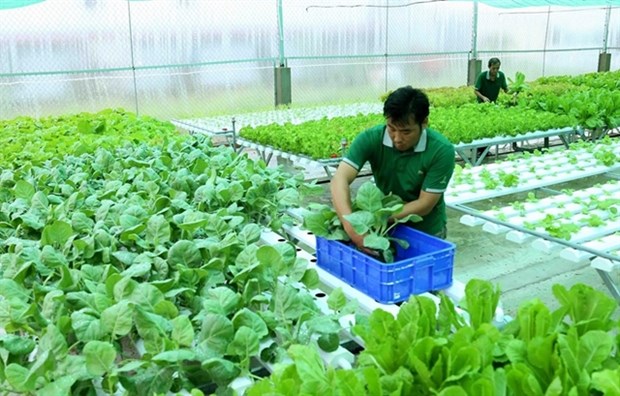Kien Giang to spend 1.3 million USD on improving cooperatives
The Mekong Delta province of Kien Giang will spend nearly 30 billion VND (1.3 million USD) this year to support the development of the collective economy and new cooperatives.
 Growing organic vegetables at an agriculture co-operative in Kien Giang Province’s Rach Gia City (Photo: VNA)
Growing organic vegetables at an agriculture co-operative in Kien Giang Province’s Rach Gia City (Photo: VNA)Nguyen Giang Thanh, Vice Chairman of the provincial People’s Committee, said the province will focus on improving the operational efficiency of cooperatives.
It will provide professional skills in management, production and business for members of cooperatives and co-operative groups.
It will also organise trade promotion activities for the products of cooperatives and co-operative groups, which will be provided a part of the cost of participating in trade fairs, exhibitions and forums at home and abroad.
The province will help cooperatives and cooperative groups with brand names and origin traceability, and provide them with a part of the cost of renting places for showing and selling their products.
The province will offer support to four cooperatives to build facilities for agricultural processing this year. They include the Tan Huy Hoang Aquaculture Breeding Co-operative in Ha Tien City, the Go Quao Youth Organic Agriculture Cooperative and the Thuan Phat Handicraft Cooperative in Go Quao District, and the Hieu Phat Agriculture Service Cooperative in Vinh Thuan District.
Tan Huy Hoang, for instance, will be given financial support to build a workshop for initial processing of products and packaging of products, as well as other production facilities.
Kien Giang, the country’s largest rice producer, has 2,228 cooperative groups, including 1,989 agriculture cooperative groups which have a total farming area of nearly 72,000ha and create jobs for 7,000 labourers.
Many cooperative groups rotate rice cultivation and shrimp breeding in the same fields, engage in aquaculture, breed cows, make handicraft products, grow flowers, or provide irrigation services.
They operate effectively and can be developed into cooperatives, according to the province’s Cooperative Alliance.
Under the 2012 Cooperative Law, a cooperative group must have at least three members, and a cooperative should have at least seven members.
The province has 462 cooperatives, including 410 agriculture cooperatives, up 200 cooperatives against 2016.
The agriculture cooperatives cultivate rice and other crops on a total of 59,517ha, accounting for 12.8 percent of the province’s total farming land, according to the province’s Co-operative Alliance.
The cooperatives have helped their members to apply advanced farming techniques and reduce the number of input materials used in agricultural production. This has increased the income of their members by 700,000 – 3.2 million (30 – 140 USD) per hectare a crop.
Many cooperatives have developed value chains for the province’s key products as well as linkages with companies that buy products.
The Tan Hung Agriculture Cooperative in Chau Thanh District’s Giuc Tuong Commune has cooperated with companies to grow rice and secure outlets for its members.
Le Minh Hai, chairman of Tan Hung, said the cooperative’s rice growing areas have farm contracts and the members no longer worry about outlets.
“The life of cooperative members has improved and no one is poor,” he said.
The Rach Gia Organic Agriculture Cooperative in Rach Gia City rotates rice cultivation and shrimp breeding under organic standards on a total area of 50ha in An Bien District.
The cooperative’s three rice products - Kim Thien Loc Nang Huong rice, Kim Thien Loc red brown rice and Kim Thien Loc black brown rice - have been certified as four-star OCOP products under the country’s one commune – one product (OCOP) programme in which the highest level is five stars.
The cooperative produces 125 – 130 tonnes of the three rice products a year and sells them mostly to supermarkets.
Tran Thanh Dung, chairman of the province’s Cooperative Alliance, said the province will develop cooperatives that produce the province’s key products with value chains and high export value.
“The province encourages cooperatives in sectors and fields suited to the economic zoning plan and with linkages [with companies] to produce high-quality products with brand names for export,” he said.
The province plans to establish 15 new cooperatives, including nine agriculture cooperatives, and 50 cooperatives groups this year.
The province aims to have more than 85 percent of its cooperatives see profits this year./.













